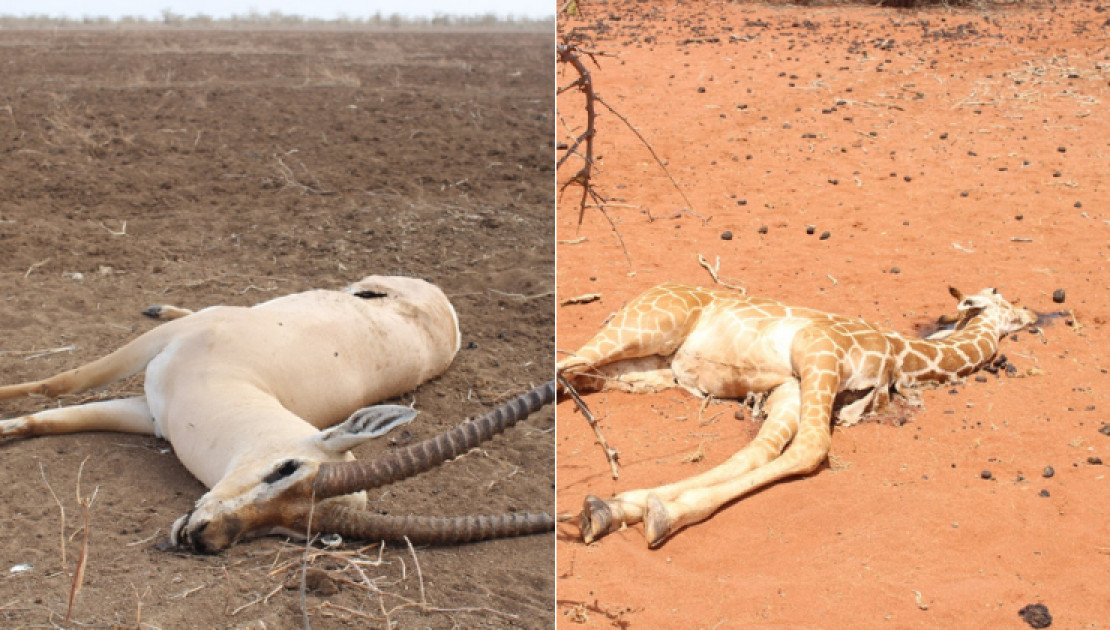Drought ravages people, livestock, wildlife in North-Eastern Kenya

People,
livestock and wildlife in northeastern Kenya are in the throes of a devastating
drought following the failure of two rainy seasons, a crisis that has been on a
worsening trend in Arid and Semi-Arid counties in the country.
The drought has left in its wake massive loss of livelihoods for northeastern Kenya residents, majority of whom are pastoralists who keep cattle, goats, sheep and camels.
In Shantabak village in Lagdera, Garissa County, what was once lush grazing ground near a watering hole is now littered with carcasses of livestock. The grazing field smells of rotting carcasses in what has been dubbed as #DryDeath.
“We had 950 goats but now there are only 500. They are dying daily,” says Ismael Aden, a Shantabak resident who has been left with no other alternative but to boil maize “githeri” for his remaining herd. To make the food palatable to the animals, Ismail says he adds salt or sugar and cooking fat otherwise “they don’t eat.” To date, Ismael has also lost 32 cows to the drought, and has only 44 left.
In this sub county, he is not the only one feeding his livestock “githeri.” The livestock farmers feed their cows between 2kg-5kg of “githeri” daily. The amount depends on each farmer’s ability and the cows are fed at least three times a day.
While still at Ismael’s homestead, he dragged out three carcasses of goats to the former grazing field. Since morning that day, he had lost eight goats. One more was too weak to stand and was struggling to breathe.
“They used to take care of us. Now it is the cattle that need our help,” says Ismael, adding that his children have to miss school to tend to the livestock.
“Children don’t go to school because I need them to tend to the goats. When the goats were healthy, they moved as a herd. Now some of them are too weak and can’t move as a group so you need many herders to take care of the different groups according to their strength ,” says Ismael.
To save their cattle from the long drought, several Shantabak residents teamed up and moved their cows to Somalia but some of them still lost more than half of their stock.
“We moved in June [2021]. I had about 250 heads of cattle. There were many people from Lagdera. It rained a little in Somalia but in September we lost many cattle to the drought. I now have 96 head of cattle,” said Siad Abdi, another resident of Shantabak village.
Mohamed Idriss, the Shantabak village elder, says their grazing fields had 27,000 cows but only 1,500 remain, a devastating blow to the community from the two failed rainy seasons.
The October-December 2020 short rains and the March-May 2021 long rains were characterised by late onsets, below average cumulative quantities, and poor distribution both in time and space.
Worse still, the October-December 2021 short rains have also been delayed and forecasts indicate they will be below-average compounded by the negative Indian Ocean Dipole.
According to the latest Integrated Phase Classification (IPC) analysis, there are now at least 2.1 million people in Kenya who are severely food insecure and adopting irreversible coping strategies to meet their minimum food needs. The number of affected is expected to rise to nearly 2.4 million by the end of November this year.
Wildlife has not been spared either. Giraffes, Grant’s Gazelles and warthogs are some of the wild animals that have succumbed to thirst and lack of pasture.
The northeastern region is home to the rare antelope species, hirola, with only about 500 left in the world. This species is listed by the International Conservation Union (IUCN) as “critically endangered.” The northerneastern Kenya landscape is also home to the reticulated giraffe whose numbers may be negatively impacted by the current drought and climate change crisis.
“Three months down the line, we have lost 79 giraffes in Bor-ana Conservancy...We have lost 50 ostriches and six gerenuks. It is really hurting when you see wildlife die and there is nothing you can do,” lamets Yussuf Hassan, Manager, Bor-ana Conservancy.
Livestock now has to contend with wildlife in watering holes. Carcasses of wild giraffes and warthogs are littered near livestock watering holes and alongside roads in Lagdera.
“If the species that are affected are either endangered or critically endangered species like hirola antelopes where globally we have only 500, we can have these species driven to extinction,” warns Dr. Yussuf Adan Wato, Head of Biodiversity, Science and Innovation, World Wide Fund for Nature-Kenya (WWF-Kenya).
Kenya Wildlife Service’s Assistant Director, Eastern Conservation Area, Captain Robert Obrein, says the only solution left to mitigate water shortage for wildlife is water trucking.
“In the parks we could feed wildlife. But in such places it is difficult to even think of feeding them because it is a conservancy [Bor-ana] and we don’t even know where they are. The truth is this time round it is not good for wildlife,” says Capt. Obrein.
Want to send us a story? SMS to 25170 or WhatsApp 0743570000 or Submit on Citizen Digital or email wananchi@royalmedia.co.ke
Comments
No comments yet.


Leave a Comment